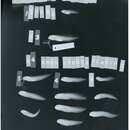Diagnostic Description
provided by Fishbase
Dark brown to blackish with anal, caudal and posterior half of dorsal fins yellow. female urogenital region conspicuously pigmented, much darker than surrounding area. Dorsal rays usually VII,25-26; pectoral rays usually 16; pelvic spine hidden; segmented caudal rays 14, all unbranched; lateral-line tubes 4-8; teeth incisiform, fewer than 50 in each jaw with large canine on side of both upper and lower jaw; head cirri absent; dorsal and anal fin bound to caudal fin by membrane, body depth about 4.1-4.4 in SL (Ref. 90102).
Life Cycle
provided by Fishbase
Oviparous, distinct pairing (Ref. 205).
Morphology
provided by Fishbase
Dorsal spines (total): 7 - 8; Dorsal soft rays (total): 24 - 27; Analspines: 2; Analsoft rays: 18 - 23
Biology
provided by Fishbase
Adults inhabit shallow coral reefs, probably (Ref. 90102). Oviparous. Eggs are demersal and adhesive (Ref. 205), and are attached to the substrate via a filamentous, adhesive pad or pedestal (Ref. 94114). Larvae are planktonic, often found in shallow, coastal waters (Ref. 94114).
- Recorder
- Cristina V. Garilao
Comprehensive Description
provided by Smithsonian Contributions to Zoology
Enchelyurus flavipes Peters
Enchelyurus flavipes W. Peters, 1868, p. 26 [Singapore, ZMB 5193].
Enchelyurus flavipes var. nigerrima Weber, 1913, p. 545 [Insel Barang bei Makassar; ZMB 5193].
Weber differentiated his variety, nigerrima, from the typical form only on the basis of the variety’s being darker. The two forms were synonymized by de Beaufort (in de Beaufort and Chapman, 1951) without comment. There is considerable variation in color pattern among specimens within a single collection and I do not believe any subspecific categories are merited. I am unable to place Gonto Soea, the locality on the label with the holotype of nigerrima, or to explain the discrepancy between the published locality (Insel Barang) for the holotype and that given on the label. Both places are cited as being near Makassar (Celebes).
Philippine specimens of E. flavipes have generally higher numbers of total dorsal and anal fin ray elements than do specimens from Singapore (Table 1).
E. flavipes is essentially an Indo-Malayan species, overlapping in distribution little if any that of E. kraussi, whose distribution, in general, surrounds that of E. flavipes (Figure 5).
MATERIAL EXAMINED.–Singapore: ZMB 5193 (2: 48.3–51.8, syntypes of E. flavipes), CAS 24692 (7: 32.9–13.8). Celebes: Gonto Soea (near Makassar), RMNH 20813 (17.6, holotype of E. flavipes variety nigerrima); Great Tobea Island, USNM 137864 (12: 27.1–44.6, including two cleared and stained). Sulu Islands: Tataan-Simalue Island, USNM 137862 (25.4), USNM 137863 (41.4); Sitankai, CAS SU35780 (24.8). Philippine Islands: Culion Island, CAS SU28441 (32.5).
- bibliographic citation
- Springer, Victor G. 1972. "Synopsis of the tribe Omobranchini with descriptions of three new genera and two new species (Pisces: Blenniidae)." Smithsonian Contributions to Zoology. 1-31. https://doi.org/10.5479/si.00810282.130
Comprehensive Description
provided by Smithsonian Contributions to Zoology
Enchelyurus flavipes Peters
Springer (1972a) incorrectly cited RMNH 20813, from Gonto Soea, near Makassar, and ZMB 5193, from Singapore, as the types of Enchelyurus flavipes var. nigerrima Weber. The correct catalog number for the two syntypes is ZMA 112.678, from Barang Island near Makassar. We have examined both syntypes and find no reason to recognize the validity of Weber’s infraspecific name.
Menon and Talwar (1972) reported on a specimen of E. flavipes (as E. flaviceps) from Galathea Bay, Great Nicobar Island. If their identification of the specimen is correct, the locality would represent the first record of E. flavipes in the Indian Ocean.
- bibliographic citation
- Springer, Victor G. and Gomon, Martin F. 1975. "Revision of the blenniid fish genus Omobranchus, with descriptions of three new species and notes on other species of the tribe Omobranchini." Smithsonian Contributions to Zoology. 1-135. https://doi.org/10.5479/si.00810282.177
Enchelyurus flavipes
provided by wikipedia EN
Enchelyurus flavipes, the yellowfin blenny, is a species of combtooth blenny from the western Pacific Ocean. It occasionally makes its way into the aquarium trade.[2]
References

- license
- cc-by-sa-3.0
- copyright
- Wikipedia authors and editors
Enchelyurus flavipes: Brief Summary
provided by wikipedia EN
Enchelyurus flavipes, the yellowfin blenny, is a species of combtooth blenny from the western Pacific Ocean. It occasionally makes its way into the aquarium trade.
- license
- cc-by-sa-3.0
- copyright
- Wikipedia authors and editors

